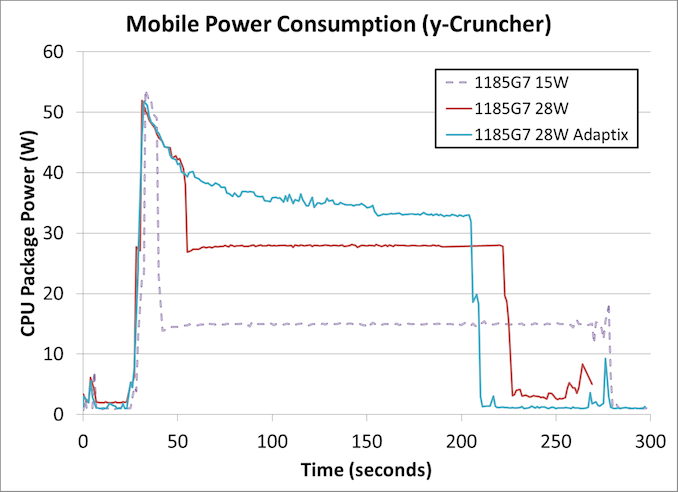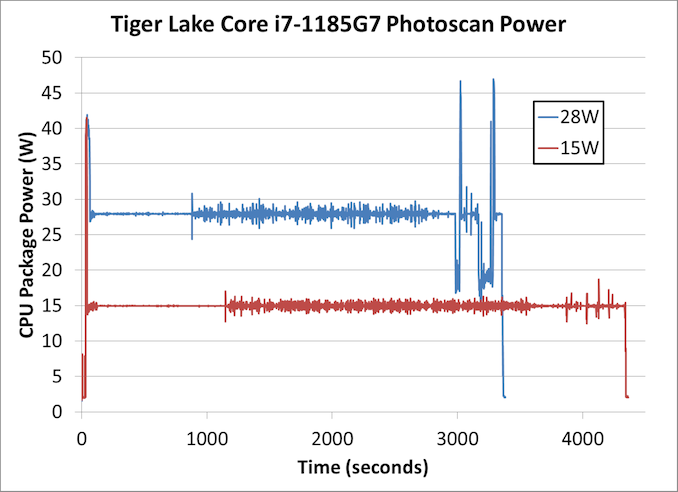Intel’s Tiger Lake 11th Gen Core i7-1185G7 Review and Deep Dive: Baskin’ for the Exotic
by Dr. Ian Cutress & Andrei Frumusanu on September 17, 2020 9:35 AM EST- Posted in
- CPUs
- Intel
- 10nm
- Tiger Lake
- Xe-LP
- Willow Cove
- SuperFin
- 11th Gen
- i7-1185G7
- Tiger King
Comparing Power Consumption: TGL to TGL
On the first page of this review, I covered that our Tiger Lake Reference Design offered three different power modes so that Intel’s customers could get an idea of performance they could expect to see if they built for the different sustained TDP options. The three modes offered to us were:
- 15 W TDP (Base 1.8 GHz), no Adaptix
- 28 W TDP (Base 3.0 GHz), no Adaptix
- 28 W TDP (Base 3.0 GHz), Adaptix Enabled
Intel’s Adaptix is a suite of technologies that includes Dynamic Tuning 2.0, which implements DVFS feedback loops on top of supposedly AI-trained algorithms to help the system deliver power to the parts of the processor that need it most, such as CPU, GPU, interconnect, or accelerators. In reality, what we mostly see is that it reduces frequency in line with memory access stalls, keeping utilization high but reducing power, prolonging turbo modes.
Compute Workload
When we put these three modes onto a workload with a mix of heavy AVX-512 compute and memory accesses, the following is observed.
Note that due to time constraints this is the only test we ran with Adaptix enabled.
This is a fixed workload to calculate 2.5 billion digits of Pi, which takes around 170-250 seconds, and uses both AVX-512 and 11.2 GB of DRAM to execute. We can already draw conclusions.
In all three power modes, the turbo mode power limit (PL2) is approximately the same at around 52 watts. As the system continues with turbo mode, the power consumed is decreased until the power budget is used up, and the 28 W mode has just over double the power budget of the 15 W mode.
Adaptix clearly works best like this, and although it initially follows the same downward trend as the regular 28 W mode, it levels out without hitting much of a ‘base’ frequency at all. Around about the 150 second mark (120 seconds into the test), there is a big enough drop followed by a flat-line which would probably indicate a thermally-derived sustained power mode, which occurs at 33 watts.
The overall time to complete this test was:
- Core i7-1185G7 at 15 W: 243 seconds
- Core i7-1185G7 at 28 W: 191 seconds
- Core i7-1185G7 at 28 W Adaptix: 174 seconds
In this case moving from 15 W to 28 W gives a 27% speed-up, while Adaptix is a total 40% speed-up.
However, this extra speed does come at the cost of total power consumed. With most processors, the peak efficiency point is when the system is at idle, and while these processors do have a good range of high efficiency, when the peak frequencies are requested then we are in a worst case scenario. Because this benchmark measures power over time, we can integrate to get total benchmark power consumed:
- Core i7-1185G7 at 15 W: 4082 joules
- Core i7-1185G7 at 28 W: 6158 joules
- Core i7-1185G7 at 28 W Adaptix: 6718 joules
This means that for the extra 27% performance, an extra 51% power is used. For Adaptix, that 40% extra performance means 65% more power. This is the trade off with the faster processors, and this is why battery management in mobile systems is so important - if a task is lower priority and can be run in the background, then that is the best way to do it to conserve battery power. This means things like email retrieval, or server synchronization, or thumbnail generation. However, because users demand the start menu to pop up IMMEDIATELY, then user-experience events are always put to the max and then the system goes quickly to idle.
Professional ISV Workload
In our second test, we put our power monitoring tools on Agisoft’s Photoscan. This test is somewhat of a compute test, split into four algorithms, however some sections are more scalable than others. Normally in this test we would see some sections rely on single threaded performance, while other sections use AVX2.
This is a longer test, and so the immediate turbo is less of a leading factor across the whole benchmark. For the first section the system seems content to sit at the respective TDPs, but the second section shows a more variable up and down as power budget is momentarily gained and then used up immediately.
Doing the same maths as before,
- At 15 W, the benchmark took 4311 seconds and consumed 64854 joules
- At 28 W, the benchmark took 3330 seconds and consumed 92508 joules
For a benchmark that takes about an hour, a +30% performance uplift is quite considerable, however it comes at the expense of +43% power. This is a better ratio than the first compute workload, but still showcases that 28 W is further away from Tiger Lake’s ideal efficiency point.
Note that the power-over-time graph we get for Agisoft on a mobile processor looks very different to that of a desktop processor, as a mobile processor core can go above the TDP budget with fewer threads.
This leads to the dichotomy of mobile use cases with respect to the marketing that goes on for these products - as part of the Tiger Lake launch, Intel was promoting its use for streaming, professional workflows such as Adobe, video editing and content creation, and AI acceleration. All of these are high-performance workloads, compared to web browsing or basic office work. Partly because Tiger Lake is built on the latest process technology, as well as offering Intel’s best performing CPU and GPU cores, the product is going to be pitched in the premium device market for the professionals and prosumers that can take advantage.












253 Comments
View All Comments
ikjadoon - Thursday, September 17, 2020 - link
You wrote this twice without any references, but I'll just write this once:AMD is literally moving to custom Wi-Fi 6 modems w/ Mediatek (e.g., like ASMedia and AMD chipsets): https://www.tomshardware.com/news/report-amd-taps-...
PCIe4: it doesn't need to 'max out' a protocol to be beneficial and likewise allows fewer lanes for the same bandwidth (i.e., PCIe Gen4 also powers the DMI interface now, no?).
Thunderbolt 4 is genuinely an improvement over USB4. Anandtech wrote an entire article about TB4: https://www.anandtech.com/show/15902/intel-thunder... (mandates unlike USB4, 40 Gbps, DMA protection, wake-up by dock, charging, daisychaining, etc). Anybody who's bought a laptop in the past two years know that "USB type-C" is about as informative as "My computer runs an operating system."
AVX512 / DLboost: fair, nobody cares on a thin-and-light laptop.
LPDDR5 is likely coming in 2021 to a Tiger Lake refresh around CES. Open game how many OEMs will wait; noting very few of the 100s of laptop design wins have been released, I suspect many top-tier notebooks will wait.
Billy Tallis - Thursday, September 17, 2020 - link
I'd be surprised if the chipset is using gen4 speeds for the DMI or whatever they call it in mobile configurations. The PCIe lanes downstream of the chipset are all still gen3 speed, so there's not much demand for increased IO bandwidth. And last time, Intel took a very long time to upgrade their chipsets and DMI after their CPUs started offering faster PCIe on the direct attached lanes.JayNor - Saturday, September 19, 2020 - link
4 lanes of pcie4 are on the cpu chiplet, as are the thunderbolt io. They can be used for GPU or SSD.Billy Tallis - Saturday, September 19, 2020 - link
Did you mean to reply to a different comment?RedOnlyFan - Friday, September 18, 2020 - link
Lol this is so uneducated comment. Telling wrong stuff twice doesn't make it correct.Pcie4 implemented properly should consume less power than pcie3.
Thunderbolt 4 is not USB 4. Only tb3 was open sourced to USB 4 so USB 4 will be a subset for tb3 thank Intel for that.
There are more AI/ML used in the background than you realize. If you expect people to do highly multi threaded rendering stuff.. Why not expect AI/ML stuff?
And 2022 is still 1.5 year away. So amd is entering the party after its over.
JayNor - Saturday, September 19, 2020 - link
Thunderbolt 4 doubles the pcie speed vs Thunderbolt 3 that was donated for USB. Intel has also now donated the Thunderbolt 4 spec.Spunjji - Friday, September 18, 2020 - link
They have 4 (four) lanes of PCIe 4.0 - that provides the same bandwidth as Renoir's 8 lanes of 3.0I get that you're one of those posters who just repeats a list of features that Intel has and AMD doesn't in order to declare a "win", but seriously, at least pick one that provides a benefit.
JayNor - Saturday, September 19, 2020 - link
The m.2 pcie4 chips use 4 lanes. Seems like a good combo with Tiger Lake. AMD would need to use up 8 lanes to match it with their current laptop chips.Rudde - Saturday, September 19, 2020 - link
Problem is that there isn't any reasonable mobile pcie4 SSDs yet. Same problem with lpddr5. Tiger Lake will get them when they become available. Renoir was released half a year ago; all AMD based laptops will wait for next gen before adopting these technologies anyway.If you want to argue that AMD is behind, highlight what Ice Lake has, but Renoir doesn't have.
Spunjji - Saturday, September 19, 2020 - link
Why would they bother? There are no performance benefits to using a PCIe 4 SSD in the kinds of systems TGL will go into. You can't get data off it fast enough for the read speed to matter, and it has no effect on any of the applications anyone is likely to use on a laptop that has no GPU. This is aside from Rudde's point about there currently being no products that suit this use case.